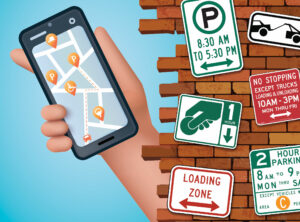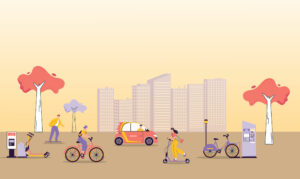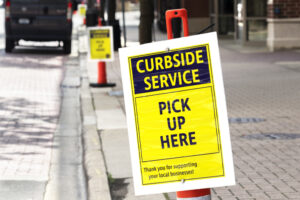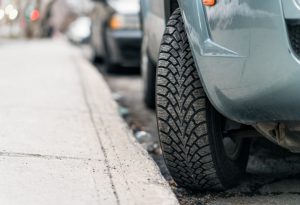Developing a Curb Management Strategy: Three Factors of Formulation
By Andrew Lamothe and Jason Sutton, CAPP
 As cities navigate complex parking environments, adapt new policies, and integrate innovations, curb management continues its trend toward mainstream adoption. Most if not all parking and transportation experts across the U.S. agree that an effective curb management strategy is a priority, especially as many cities contend with double digit population growth. Naturally, this growth breeds competition at the curb.
As cities navigate complex parking environments, adapt new policies, and integrate innovations, curb management continues its trend toward mainstream adoption. Most if not all parking and transportation experts across the U.S. agree that an effective curb management strategy is a priority, especially as many cities contend with double digit population growth. Naturally, this growth breeds competition at the curb.
Here are three factors to help formulate a strategy:
- Set strategic goals – Strategic goals should correlate with identified challenges. What are the goals if solving for:
-
- Congestion
- Inventory Management
- Efficiency
- Equity
- All the above
After goals and outcomes are defined, move to outline Key Performance Indicators (KPIs). KPI’s will serve as project milestones.
- Identify Challenges
-
- Legacy code and policies. These are potential hurdles to innovation. Removing or revising these hurdles creates a clear path to problem solving solutions.
- Innovate don’t imitate. Curb management strategies don’t adhere to the adage “imitation is the sincerest form of flattery”. Every city, university, etc. is going to have its own unique obstacles, so innovate accordingly.
- Tunnel vision. An effective strategy considers all aspects of the ecosystem (garages, lots, EV, loading zones, timed parking, bike share, etc.) and implements accordingly.
- Funding. Does an adequate budget exist? The federal SMART grant was created for these solutions. Depending on scope, grant money may fully fund the project or augment resources.
- Participation. Strategies succeed with stakeholder participation. Collaboration on infrastructure reviews, project scope, and a detailed execution plan is paramount.
- Solutions
Technologies serving the curb management space are all striving to solve the aforementioned problems. However, a “one size fits all” solution doesn’t exist, so alignment on goals and provider abilities is a must. The spectrum ranges from tech that specializes in loading zone enforcement to comprehensive curb management platforms. Considerations should be made for accuracy and integration capabilities, while identifying the solutions that meet the unique and specific needs of the operation.
Andrew Lamothe is Vice President of Sales and Marketing for Cleverciti. He can be reached at andrew.lamothe@cleverciti.com.
Jason Sutton, CAPP, is Vice President of Channel Partnerships for Passport. He can be reached at Jason.Sutton@passportinc.com.


 By Benito Pérez, CAPP; Lawrence Marcus; Alejandra Argudin, CAPP; and Michael Sawyer
By Benito Pérez, CAPP; Lawrence Marcus; Alejandra Argudin, CAPP; and Michael Sawyer How’s your curbside management game? Parking and mobility professionals might have known about curb management before COVID-19 but most other people didn’t–but they learned fast how critical it is to manage that valuable chunk of real estate.
How’s your curbside management game? Parking and mobility professionals might have known about curb management before COVID-19 but most other people didn’t–but they learned fast how critical it is to manage that valuable chunk of real estate. Accelerating growth in the use of curb space has resulted in the demands on curb space to exceed supply. Today, transportation network companies such as Uber and Lyft complete more than 4 billion annual trips globally–the bulk of which begin and end on urban curbsides. E-commerce continues to grow, with goods delivery companies making millions of stops on city curbsides daily. Looking ahead to the not-too-distant future, the widespread adoption of connected and automated vehicles (CAVs) has the potential to reduce the need for parking, but could also dramatically increase the demand for short term pick-up and drop-off spaces on the curb.
Accelerating growth in the use of curb space has resulted in the demands on curb space to exceed supply. Today, transportation network companies such as Uber and Lyft complete more than 4 billion annual trips globally–the bulk of which begin and end on urban curbsides. E-commerce continues to grow, with goods delivery companies making millions of stops on city curbsides daily. Looking ahead to the not-too-distant future, the widespread adoption of connected and automated vehicles (CAVs) has the potential to reduce the need for parking, but could also dramatically increase the demand for short term pick-up and drop-off spaces on the curb. When we speak about curb equity, we are not speaking about proportional access to the curb. If access were proportional, national delivery fleets would dominate all loading zones and cars would dominate all other on-street inventory. When we speak about curb equity, we are referring to equitable access to the curb within an ecosystem that is aware and considers the various people, business, and vehicles that utilize the curb. Curb space is limited and the competition for this space increases almost daily. Parking administrators and policy makers work with their staffs to craft policy that addresses this added volume but must also consider the downstream effects of these policies. What do we do to accommodate the increase in delivery vehicles? How do we best manage TNC drop-offs and pick-ups? When viewing things through this prism of curb equity, we must also answer questions like how curbside regulations affect the people using the curb? Are we treating all of my citizenship equitably? Did this new initiative disproportionally affect the business community?
When we speak about curb equity, we are not speaking about proportional access to the curb. If access were proportional, national delivery fleets would dominate all loading zones and cars would dominate all other on-street inventory. When we speak about curb equity, we are referring to equitable access to the curb within an ecosystem that is aware and considers the various people, business, and vehicles that utilize the curb. Curb space is limited and the competition for this space increases almost daily. Parking administrators and policy makers work with their staffs to craft policy that addresses this added volume but must also consider the downstream effects of these policies. What do we do to accommodate the increase in delivery vehicles? How do we best manage TNC drop-offs and pick-ups? When viewing things through this prism of curb equity, we must also answer questions like how curbside regulations affect the people using the curb? Are we treating all of my citizenship equitably? Did this new initiative disproportionally affect the business community? By Robert Ferrin and Brandy Stanley, CAPP
By Robert Ferrin and Brandy Stanley, CAPP It’s no news to industry members that the COVID-19 pandemic brought about a change of thinking around parking–after all, parking and mobility professionals are the ones who largely thought through and enacted curb management strategies to help businesses and communities. But as the larger world takes notice, the mainstream media is asking: What does this mean for the future?
It’s no news to industry members that the COVID-19 pandemic brought about a change of thinking around parking–after all, parking and mobility professionals are the ones who largely thought through and enacted curb management strategies to help businesses and communities. But as the larger world takes notice, the mainstream media is asking: What does this mean for the future? Curb management planning and strategy was already well underway in Washington, D.C., when the COVID-19 pandemic hit, but the virus still managed to change almost everything. On-demand delivery services–DoorDash, Grubhub, etc.–took over crowded curbsides in what felt like overnight and demand for temporary parking space outside businesses skyrocketed from city residents taking the opportunity to pick up their own groceries, meals, or other necessities without violating stay-home orders.
Curb management planning and strategy was already well underway in Washington, D.C., when the COVID-19 pandemic hit, but the virus still managed to change almost everything. On-demand delivery services–DoorDash, Grubhub, etc.–took over crowded curbsides in what felt like overnight and demand for temporary parking space outside businesses skyrocketed from city residents taking the opportunity to pick up their own groceries, meals, or other necessities without violating stay-home orders. By Meera Raja
By Meera Raja By Dawn Miller
By Dawn Miller